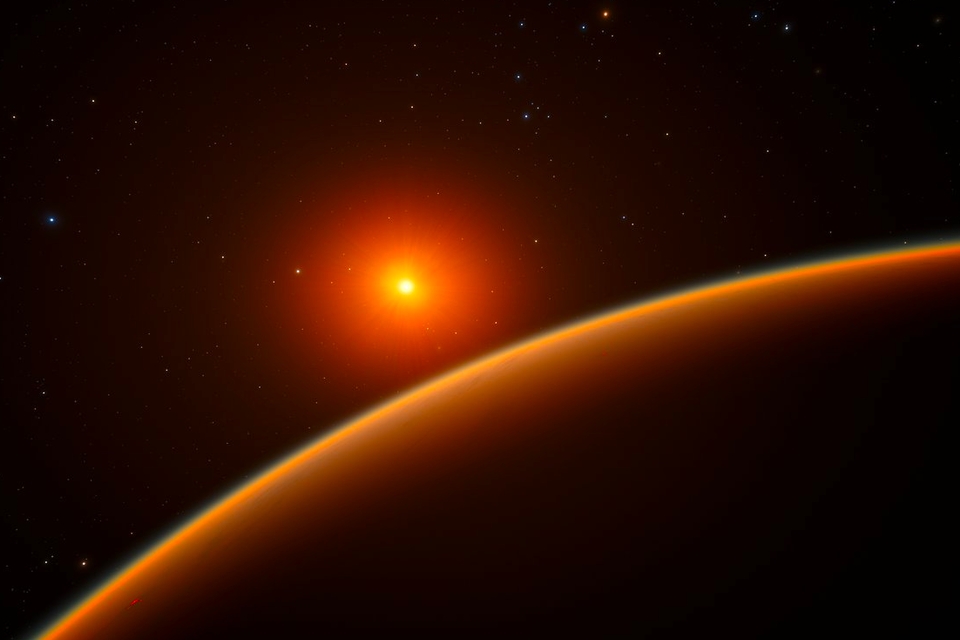Meet Gliese 486b, a planet that – much to the excitement of astronomers – is perfect for atmospheric research.
An international team of researchers has discovered a new planet just 26 light years from Earth. The planet orbits a red dwarf and is slightly larger – but considerably warmer – than Earth. The temperatures are – because the planet is very close to the red dwarf star – above 400 degrees Celsius. “Gliese 486b takes 1.47 days to complete a orbit around the parent star, with the same side of the planet always facing the parent star,” said researcher Trifon Trifonov. “Because the star is so close, the planet is heated considerably, making the surface warm and dry, with here and there volcanoes and glowing lava rivers.”
The discovery
What the discovery of this planet special is that astronomers have managed to detect Gliese 486b in two different ways. Most exoplanets are only discovered in one way (usually through the transit method, where a planet betrays its presence by moving in front of the parent star). But the existence of Gliese 486b can be inferred not only from the transmit method, but also from very small rocking movements of the parent star, caused by the planet’s gravitational pull. The rocking movements of the parent star have been detected using a telescope in Spain. And space telescope TESS then saw regular, small decreases in brightness from Gliese 486 that indicated that every now and then a planet would pass in front of the star, blocking a small portion of the starlight.
Because the planet could be detected in two ways, researchers can tell us a lot about it right away. For example, the rocking parent star not only tells us that there is a planet to be found, but also gives away more about the mass and orbit of the planet. Gliese 486b appears to be quite close to the parent star and to be about 2.8 Earth masses. The transit method, in turn, reveals more about the size. For example, Gliese 486b appears to have a radius 1.3 times larger than the radius of the Earth.
Clipped
The discovery of Gliese 486b is causing the necessary excitement among astronomers. And that has everything to do with the fact that the planet – if it has an atmosphere – is perfect for atmospheric research. Gliese 486b is relatively close, bright and frequently moves in front of the parent star.
The latter is a nice bonus, because the moment when the planet stands between us and the parent star is the moment to find out the composition of any atmosphere. By analyzing the starlight that then seeps through the planet’s atmosphere, researchers can find out which elements are present in that atmosphere. “Gliese 486b is a remarkable discovery,” said Trifonov. “This planet is likely to serve as the ‘Rosetta Stone’ for atmospheric research on rocky planets.” While the Rosetta Stone helped archaeologists decipher the hieroglyphs, Gliese 486b can help us understand atmospheres of Earth-like exoplanets. And that, according to Trifonov, is also due to the perfect temperature of the planet. “If the temperature had been 100 degrees higher, then the entire surface would have been lava and the atmosphere made up mostly of evaporated rock and we wouldn’t be able to learn anything about the planet’s original atmosphere.”
James Webb
Despite all the excitement, the investigation into the possible atmosphere of Gliese 486b is still delayed. The current telescopes are not very suitable for such observations. “With the James Webb Space Telescope we have the greatest chance of success, ”thinks Trifonov. This space telescope should be launched later this year. “Shortly after James Webb becomes operational, we can start planning observations from Gliese 486b, but even in the best-case scenario, they won’t take place for a year.”
About 26 light-years away, Gliese 486b is relatively close. But in recent years, exoplanets have been discovered that are even closer. Think of Proxima b of Star of Barnard b. They are also very interesting, says Trifonov. But while Gliese 486b is further away, it is in some ways more interesting. “I think Gliese 486b can answer very different scientific questions. Proxima b and Star of Barnard b are of course also very interesting planets, for example Proxima b is located in the habitable zone. But neither of them move (seen from Earth, ed.) In front of their star, so we cannot form an image of their atmospheres. Gliese 486b might be able to tell us more about its atmosphere. ” And with that information in our pocket, we may be able to start speculating a bit more specifically about what the atmospheres of other planets – like Proxima b and Barnard’s Star – look like. “Basically all planets and observations are interesting, because they help us to get a better picture of the formation and evolution of planets.”-
Trifonov eagerly awaits the observations from the James Webb telescope. “It seems likely that Gliese 486b will be the first super-Earth to display its atmosphere – if the planet has it – at the James Webb Space Telescope,” he said. While waiting for that data, the search for other nearby exoplanets continues. Perhaps there are more to be found around Gliese 486, says Trifonov. And otherwise around other red dwarf stars. But planets like Gliese 486b – which is so close, so bright, and so often ahead of the parent star that it seems like a matter of time before we fully dissect any atmosphere – they are probably very, very rare.
–
Keep amazed ✨
Receive the most beautiful space photos and interesting popular science articles every Friday. Together with 50,000 others, receive the free Scientias Magazine.


